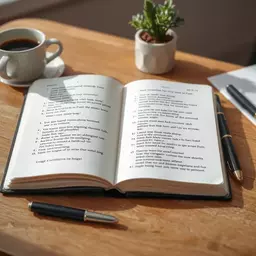Exposition
Introduces the characters, setting, and situation.
Join Clara V. Hastings and other passionate writers. Get exclusive tips, insights, and resources to perfect your storytelling delivered straight to your inbox.
Posted on: 2025-11-01
By: Clara V. Hastings
Imagine a world where every story you craft connects deeply with your readers, leaving them eagerly turning pages. The key to achieving this lies in understanding the intricacies of plot structure. This article unveils valuable insights into how effective plot structuring can elevate your narrative and keep your audience engaged.
Understanding the essential components of plot structure can enhance your narrative. Below is a breakdown of the key elements with their descriptions.
Introduces the characters, setting, and situation.
Builds tension through a series of events leading to the climax.
The turning point where the main conflict reaches its peak.
Shows the aftermath of the climax and leads towards resolution.
Wraps up the story and resolves conflicts.
As a writer, one of the most significant decisions you'll make is how to structure your plot. A well-defined plot structure not only guides your story but also enhances its emotional depth and resonance. In this section, we'll dive into the core elements of storytelling and explore how effective plot structuring can elevate your narrative. By the end, you'll have a clearer understanding of how to craft compelling plots that keep readers engaged! To learn more about honing your skills, consider exploring resources on crafting fiction.
To start, let's define what plot structure really means. At its core, a plot structure is the organized framework of your story, outlining its events and their significance. The essential elements include:
Understanding these elements is crucial. They act like building blocks, helping you create a story that flows smoothly and keeps readers intrigued throughout.
When it comes to narrative structure, several principles guide the flow and impact of your story. One critical principle is the idea of cause and effect. Each event should logically lead to the next, maintaining a coherent connection. Additionally, think about the balance between action and reflection. Too much action without moments of introspection can leave readers breathless, while too much reflection can slow the pace. Striking that balance is key to engaging storytelling!
Also, consider the pacing of your plot. Different moments in your story call for varied pacing. For instance, during a climactic scene, you might want to speed up the narrative, while slower moments may allow for deeper character exploration. This careful balance can help you avoid common storytelling plot holes.
Plot arcs and story beats are integral to maintaining engagement. A plot arc refers to the overall progression of the story, from initial conflict to resolution. Think of it as the emotional journey your characters undertake. Meanwhile, story beats are smaller increments within the plot that mark significant shifts or developments. By outlining these beats, you can ensure your story remains dynamic and interesting.
Incorporating both plot arcs and story beats will help you create a narrative that feels cohesive and impactful. As I’ve seen in my work with writers at Perfect Your Fiction, this attention to structure can transform a good story into a great one!
Now that we’ve established the foundation of plot structure, let's discuss emotional engagement. The way you structure your plot can significantly affect how readers connect with your characters and story. When they’re emotionally invested, they’re more likely to stay engaged.
Here are some techniques to help evoke emotion through your plot structure:
By weaving these techniques into your plot, you can create a narrative that resonates with readers on a deeper level!
Character arcs are vital for emotional engagement and should align with your plot structure. A well-crafted character arc allows readers to witness growth and change, making them more invested in the character's journey. Consider mapping out your character's transformation alongside your plot points. How does each event shape them? This connection between plot and character enhances the emotional impact of your story.
Finally, let’s talk about building stakes and conflict. High stakes create tension and excitement, encouraging readers to root for your characters. You can increase stakes by:
When readers believe that everything hangs in the balance, their investment in your story will grow exponentially! Further insights into plot development steps can refine this process.
To enhance emotional resonance in your story, consider layering subplots that mirror or contrast the main plot. This technique not only adds depth but also creates a richer narrative tapestry, allowing readers to engage with multiple facets of your characters' journeys.
When it comes to enhancing your writing journey, having the right tools can make a significant difference! At Perfect Your Fiction, I believe that visual aids can simplify complex ideas and help you structure your plot more effectively. Let's explore some fantastic resources that will transform your writing process.
Utilizing visual tools can help you organize your thoughts and streamline your creative flow. These resources allow you to see the bigger picture while also focusing on the intricate details of your plot. Here are some essential tools that I recommend for any writer looking to refine their narrative structure:
Having a solid outline is crucial in crafting a compelling story! Interactive plot templates can guide you through the essential steps, ensuring you cover all necessary elements. These templates often include sections for character development, setting details, and key plot points.
Additionally, checklists can help keep you on track. You can easily identify what’s working and what needs improvement. Here are some elements to include in your plot checklist:
To further assist your writing journey, I offer downloadable resources available at Perfect Your Fiction! These resources can simplify your plotting process and help you stay organized. When you have everything laid out in front of you, it becomes easier to visualize how your story unfolds.
Make sure to check out our Fiction Fixer Toolkit as well, which provides practical tips for strengthening your narrative!
Plot diagrams can be a game-changer! They help you see the progression of your story and understand how each element connects. By visualizing your plot, you can easily spot any gaps or inconsistencies. Here are a few types of plot diagrams you might consider:
Visual storytelling is not just for filmmakers—writers can benefit from it too! By incorporating visual techniques, you can clarify complex ideas and make your plot more engaging. Consider using graphics, drawings, or even simple sketches to represent critical moments in your story! This approach also helps in crafting complex characters that resonate with readers.
This approach not only enhances your understanding but also keeps your creativity flowing. At Perfect Your Fiction, we encourage writers to embrace their unique artistic expressions—so don’t be afraid to get creative!
The five core elements are Exposition (introduces characters, setting, situation), Rising Action (builds tension), Climax (the turning point), Falling Action (shows aftermath), and Resolution (wraps up conflicts).
Striking a balance means interspersing high-action sequences with moments of character introspection. Too much action can be overwhelming, while excessive reflection can slow the pace, so vary your pacing to keep readers engaged.
Plot arcs define the overall progression and emotional journey of the story, while story beats are smaller, significant moments that drive the narrative forward. Together, they ensure the story remains dynamic, cohesive, and impactful.
To evoke emotion, use relatable characters, establish high stakes so outcomes matter, and incorporate compelling conflict. These elements help readers empathize with characters and become deeply invested in their journey.
Visual tools such as plot diagrams (e.g., Freytag's Pyramid, Story Circle) help writers visualize the progression of their story, identify gaps or inconsistencies, and see how different elements connect, ultimately streamlining the creative process.
Now that we've covered the visual tools available for plot structuring, it's time to reflect on the key strategies we've discussed! By employing these resources, you can elevate your storytelling and create a more engaging narrative experience. Remember, the goal is to make your plot resonant and compelling for your readers.
Here’s a brief overview of the strategies we've explored:
Applying these techniques will not only enhance your plot development but also create a smoother writing process. Take a moment to reflect on how you can implement these tools in your next project!
I'd love to hear about your experiences with plot structuring! Have you used any of these tools or techniques before? What worked for you? Sharing your insights can foster a supportive community of writers eager to improve their craft.
At Perfect Your Fiction, we value your voice and encourage discussions around storytelling techniques. Let’s continue this conversation and elevate our writing journeys together. Don't hesitate to reach out with your thoughts or questions! You can also explore insights on crafting relatable characters for deeper engagement.
Here is a quick recap of the important points discussed in the article:

 Every storyteller has encountered the frustration of reading a predictable character that feels like
Every storyteller has encountered the frustration of reading a predictable character that feels like
 Imagine a world where every story you craft connects deeply with your readers, leaving them eagerly
Imagine a world where every story you craft connects deeply with your readers, leaving them eagerly
 Have you ever found yourself captivated by the rhythm of a character's dialogue, feeling as though y
Have you ever found yourself captivated by the rhythm of a character's dialogue, feeling as though y